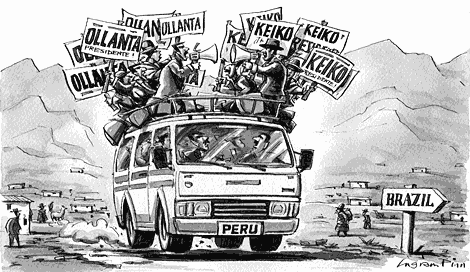
Latin America’s new shining path
May 16, 2011 - Financial Times
By Gideon Rachman
In the small towns of Peru’s Andean highlands, every spare surface has been commandeered for a poster or a mural proclaiming: “Keiko Presidente!” or “Ollanta”. The Peruvian presidential election, which will see either Keiko Fujimori or Ollanta Humala elected on June 5, will be the most closely watched poll in Latin America this year. It has become a test of whether the continent’s dramatic economic and political progress is irreversible; or whether the bad old days of authoritarianism, populism and economic chaos could still return to haunt Latin America.
In 1980, there were just three democracies in the whole of Latin America; now it is the autocracies that can be counted on the fingers of one hand. A continent that was once synonymous with the words “economic crisis” has become the toast of emerging market investors. Countries that lived in dread of capital flight now complain that there is too much “hot money” flowing in from abroad.
The rise of Brazil as a global power has overshadowed much of the rest of the continent. But the transformation of Peru, Brazil’s smaller neighbour, is in some ways even more remarkable. Once famous for a vicious Maoist insurgency, the country grew by almost 9 per cent last year – and has commitments for more than $40bn of new foreign investment in mining alone. (Peru also has the unique status of being the world’s leading exporter of both cocaine and asparagus.)
The figures show poverty falling fast in Peru – but the smart restaurants and gleaming offices of central Lima are still surrounded by crime-ridden slums, where 20 per cent of the population lack access to running water. It is a pattern of affluence surrounded by deprivation that is replicated in other megacities across Latin America – from São Paulo to Mexico City.
That inequality now threatens Peru’s stability. To the horror of many of the upper middle classes, Peru’s centrists were all eliminated in the first round of the presidential election last month. The race has come down to a contest between two populists with authoritarian streaks – Ms Fujimori and Mr Humala.
The 35-year-old Ms Fujimori is the daughter of an imprisoned former president, Alberto Fujimori. As president, Mr Fujimori laid the foundation for Peru’s success by suppressing the Maoist Shining Path movement, whose war had claimed thousands of lives. Abimael Guzmán, the renegade philosophy professor who led the Shining Path, is now in prison. But Mr Fujimori, the president who oversaw his capture, is also in jail – serving a 25-year stretch for corruption and links to death squads.
Peru’s technocrats fear a Keiko Fujimori presidency would repeat the sins of the father – undermining the country’s democratic institutions and fostering rampant corruption.
Most of the Peruvian middle class, however, seem to fear Keiko’s opponent even more. Mr Humala is a former army officer who literally shot to prominence when he led an attempted coup in 2000. His brother, Antauro, is in prison for leading yet another attempted coup in 2005. He was once close to Hugo Chávez, a ranting populist, whose “21st-century socialism” has subverted nearby Venezuela’s democracy and gravely weakened its economy. These days Mr Humala, who is just ahead in the polls, plays down his Chávez links – but many Peruvians are still wary.
If Peru, which has become a poster child for the success of liberal economic and political reforms, now slips backwards, it would send a worrying message about the fragility of reform across Latin America, where persistent inequality and weak institutions are common problems.
It is certainly possible that either a Humala or a Fujimori presidency would push Peru down the path of populist authoritarianism. Yet things need not be that grim. One reassuring aspect of the Peruvian election is the way in which both candidates have talked of Brazil, rather than Venezuela, as a model.
Luiz Inácio Lula da Silva, who recently stepped down as president of Brazil, has achieved cult-like status because he showed that it was possible to combine things that were too often mutually exclusive in Latin America: charismatic leadership and a respect for democracy; a booming market economy and social reforms that benefit the poor.
Brazil may soon be the world’s fifth-largest economy. On a recent visit there, President Barack Obama said that the US was cheering on its rise. Certainly to American eyes, Brazil is the cuddly rising power – less prickly than India and less threatening than China. It is a tribute to the skill with which Brazil is managing its rise that even a smaller neighbour such as Peru (with just 30m people to Brazil’s 190m), regards the country as a model rather than a threat.
Salamon Lerner, Mr Humala’s campaign manager, says that it is Brazil not Venezuela that his boss wants to learn from. A successful entrepreneur with a helicopter business, Mr Lerner told me in Lima last week: “If you look at Brazil and Venezuela, it is clear that Brazil is much more successful. We don’t want to drive away foreign investment. We are not crazy.” Ms Fujimori’s advisers also cite Mr Lula da Silva’s social reforms as a model.
There are plenty of good reasons for treating both candidates in Peru’s election with extreme caution. But if Brazil really has provided a model for democratic, market-friendly social progress, then Peru, and the rest of Latin America, may finally have discovered a genuine shining path.